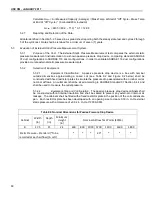
USE OM - JANUARY 2017
70
6.4
Mass Flow Procedure Requirements
6.4.1
The actual internal volume of pressure transducer assemblies and flow meter assemblies shall be
measured or calculated prior to setup and recorded with test report data. Either document hose diameters (OD
and ID) and length of hoses used, or calculate internal volume (above). This information shall be recorded along
with all other test data.
6.4.1.1
Entire length of liquid line outside of flow meter assembly connections must be the
diameter specified by the Participant
’s published installation instructions.
6.4.2
If a Participant specifies a refrigerant charge by weight, then charge shall be adjusted by adding the
cumulative internal volume of the flow meter assemblies, and pressure transducer assemblies in cubic feet, ft
3
,
times the liquid density of the refrigerant, lb*mass/ft
3
, used at the charging test condition.
6.4.3
Refrigerant side capacity q
tri
shall be calculated per ASHRAE Standard 37, Section 7.5.4 for cooling
mode and Section 7.5.5 for heating mode.
6.4.3.1
If vapor refrigerant at the indoor coil pressure tap is not superheated by at least 5°F,
or the liquid refrigerant at the indoor coil pressure tap is not sub-cooled by at least 3°F, then refrigerant
properties at the Outdoor Unit may be substituted, as long as refrigerant side capacity is adjusted by
line loss calculations per ASHRAE Standard 37 Section 7.3.3.4. If the minimum superheat values are
not met at the Outdoor Unit, then the outdoor air enthalpy method shall be used per Section 7 of this
appendix.
6.4.4
If needed in order to improve HB, the following adjustments are permitted. If such adjustments are
made the test report shall indicate the adjustments.
6.4.4.1
Pressures used may be adjusted for elevation differences between the actual pressure
tap location and the pressure transducer. If the pressure transducer is located higher than the pressure
tap location, then add the elevation head difference to the pressure transducer measurement. If the
pressure transducer is located lower than the pressure tap location, then subtract the elevation head
different from the pressure transducer measurement.
6.4.4.2
If pressure transducers are located in the outdoor or indoor test environment, they
may be temperature compensated in accordance with the Participant
’s instrument instructions.
Pressure transducer temperature range shall be suitable for the mounting location.
Section 7. Outdoor Air Enthalpy Method Requirements
7.1
Pressures measurements:
7.1.1
Shall be made with instrumentation according to the latest edition of ASHRAE Standard 41.2.
7.1.2
Shall be measured at the service connections provided on the product.
7.1.2.1
Split systems that meet the requirements of Section 5.1 shall have pressures and
temperatures measured at the Indoor Unit per Section 6.1 and 6.2.
7.1.3
Shall be taken with static pressure taps compliant with Figure 7A of ASHRAE Standard 41.2-1987.
7.2
Temperature measurements requirements:
7.2.1
Temperature measurements shall be made with instrumentation according to the latest edition of
ASHRAE Standard 41.1.





































